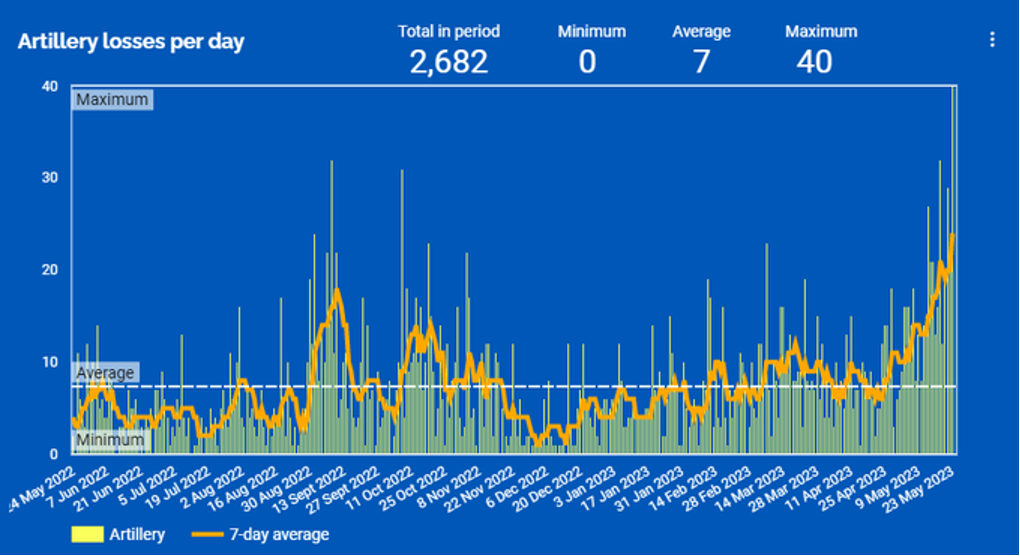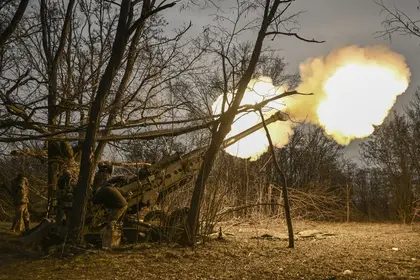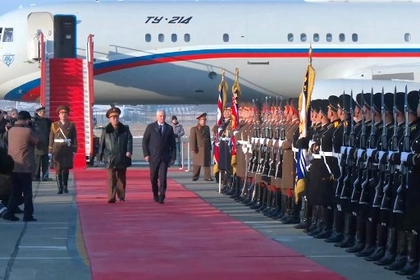1. Long-range Ukrainian strikes particularly targeting artillery are already happening
The Kyiv Post reported two weeks ago that Ukrainian military planners had begun targeting Kremlin-controlled howitzers, mortars and rocket launchers in a systematic campaign to demolish Russian artillery formations all along the fighting front.
JOIN US ON TELEGRAM
Follow our coverage of the war on the @Kyivpost_official.
According to data published on Thursday, May 25 by the watch group uacontrolmap.com, that destruction campaign is accelerating with 40 Russian artillery pieces destroyed by Ukrainian hits in the past 24 hours – close to a record for the entire war.
- See the most recently published Ukraine news reports from today.
- Ukraine War Casualties
The data collected by the group showed Russian army loss rates of its artillery weapons is, by most measures, at a wartime high.

2. Raids and special operations are underway
Ukrainian and NATO military doctrine both say that highly trained, special forces troops, operating covertly should precede a major ground offensive with behind-the-lines patrols to collect intelligence, identify weakly-defended sectors, and conduct hit-and-run raids against soft targets.
Something that looks very much like the textbook definition of pre-offensive special operations is happening right now.
On Monday 80-100 armed men using US-made MaxxPro mine-proof armored cars left north-east Ukraine, drove into Russia’s Belgorod Oblast, shot up a Russian border checkpoint.
They seem to have left, with at least three captured Russian army armored vehicles, after two days of gun and mortar fights with local troops. A pair of Russian “nationalist” militia groups, at a well-organized press conference back in Ukraine, took credit for the attacks.

‘We Need to End That Horrible, Horrible War’ – Ukraine at War Update for Dec. 23
Officially, Kyiv claimed Ukraine had nothing to do with it, while Russian official state media and military bloggers alike said it was a raid intended to distract Russia’s defenses from the big Ukrainian offensive planned in the south.
At the other end of the 1,500-kilometer front, in the Kherson sector, Ukrainian small boat raiders have repeatedly crossed portions of the Dnipro River delta - temporarily occupying villages, and calling in missile strikes on buildings used by Russian troops.
According to some reports they have completely taken over Potempkin Island in the Dnipro River which, theoretically, could become a base for a Ukrainian offensive attacks towards Crimea via assault bridges built across the river.
Much of the landscape is wet, wooded and poorly covered by roads: excellent terrain for small bands of Ukrainian infantry and poor terrain for conventional Russian defenses, which need earthworks and dry ground to support tanks and artillery.
Some of the raiders are, reportedly, from the elite 73rd Naval Center of Special Operations, Ukraine’s version of the movie-famous US Navy Seals.
By mid-May the problem of Ukrainian infantry poking around on the Dnipro’s left bank had become bad enough, that the Russian high command called in expensive cruise missile strikes on some buildings on Potempkin Island.
3. Kyiv official says it is ongoing, and has been for some time
Myhailo Podolyak, a senior advisor to the Ukrainian President, was the latest to directly confirm that Kyiv’s counter-offensive has already started. The tanks may not yet be rolling and Russian frontline positions aren’t yet under direct assault, he said, but a systematic campaign to degrade Russian defenses is in already in progress. On Thursday, Podolyak tweeted on #counteroffensive:
“1. This is not a "single event" that will begin at a specific hour of a specific day with a solemn cutting of the red ribbon. 2. These are dozens of different actions to destroy the #Russian occupation forces in different directions, which have already been taking place yesterday, are taking place today and will continue tomorrow. 3. Intensive destruction of enemy logistics is also a counteroffensive.”
Major General Kyrylo Budanov, the head of Ukraine’s Defense Intelligence Directorate of the Ministry of Defense of Ukraine, in a May 23 interview stated that Ukraine already has the “minimum [numbers] of weapons” it needs to launch a counteroffensive.
In April in an interview with the RBC-Ukraine news platform Budanov said the attack would take place as planned, “in the spring”, reaffirming a timeframe he first predicted in January.
More recently, he said that for the offensive to be very successful heavy weapons, that were then en-route, needed to arrive.
4. Clear timelines for the delivery of key heavy weapons to Ukraine are becoming defined
Two consignments of weaponry, from Sweden and Germany respectively, are not in country yet but according to many news reports will become available in the next few weeks.
The German contribution, widespread reports from that country say, will be part of the allocated 110 Leopard I tanks. Crew training in Germany is nearing completion, according to Die Welt and other German mainstream platforms.
A Cold War fighting vehicle with a good main armament, excellent optics but thinner armor than the most modern tanks, the Leopard I fills a critical gap in the Armed Forces of Ukraine (AFU) assault capability: a reliable tank able to blast Russian infantry out of its fortifications while offering fair levels of protection against Russian weapons.
The international coalition supporting Ukraine has been relatively slow to send Ukraine tanks, and the first batch of Leopard I – according to many reports a full battalion of 40 vehicles – will arrive in Ukraine in the first weeks of June, just in time for the probable launch of the main ground assault.
From Sweden, social media images and official statements from Stockholm have confirmed that three powerful weapon systems in sufficient quantities to equip a full Ukrainian combat brigade – tanks, artillery and infantry fighting vehicles – are currently being dispatched.
Highly capable armored fighting vehicles CV90 from 🇸🇪 are now on their way to 🇺🇦. pic.twitter.com/vsvDMmk7Pc
— Carl Bildt (@carlbildt) May 22, 2023
Fully modern and in some aspect state-of the art, the hundred or so Swedish combat vehicles including the CV-90 infantry fighting vehicle and Archer semi-automatic howitzer will, most likely, make the Ukrainian formation operating them the best-armed brigade on either side in the war.
It’s not clear how much training the Ukrainian army leadership will require before the unit is committed to combat, but AFU leadership already must be building the Swedish weapons’ arrival into its counteroffensive plans and timelines.
5. Observe the opposition: Moscow is reinforcing its frontline defenses - they expect something
A military lesson learnt the hard way by the Russian army, starting in late May 2022, with the arrival of US-made precision-guided HIMARS missiles launchers, was the danger of positioning heavy weapons too far forward.
Sooner or later Ukrainian military intelligence will detect the armament or air-defense radar and then a GPS-guided American missile will strike.
There are growing indications that the Russian military has planned its own heavy attacks or expects major Ukrainian assaults. Official Ukrainian sources and military channels alike, have recently reported Russian troops and their equipment moving towards likely areas from which, in Moscow’s estimation, the Ukrainian ground offensive will be launched – they’re betting on the southern sector.
The heaviest Russian troop movements, sources like pro-Russian Readovka and the Armed Forces of Ukraine (AFU) daily situation estimates suggest, are in the eastern Kherson and Zaprizhia sectors, in the path of a potential Ukrainian assault towards the city Melitopol.
Anton Gerashchenko, a Ukraine Interior Ministry official publishing often unique and detailed military intelligence since the outset of the war, said the Russian high command is shifting troops away from the north-eastern, and eastern Kharkiv and Donbas sectors, in order to build layered defenses in the south.
Heavy Russian vehicle columns on Thursday had withdrawn from positions around the Donbas cities Starobelsk, Luhansk and Krasonodon, and were heading towards the southern Zaporizhia and Kherson sectors, Gerashchenko said in a Telegram post.
Russian artillery strikes against Ukrainian frontline fortifications in southern sectors, and particularly against positions on the Dnipro right bank between the towns of Stanislav and Berislav – another potential Ukrainian river crossing site – also have intensified, other reports said.
You can also highlight the text and press Ctrl + Enter






